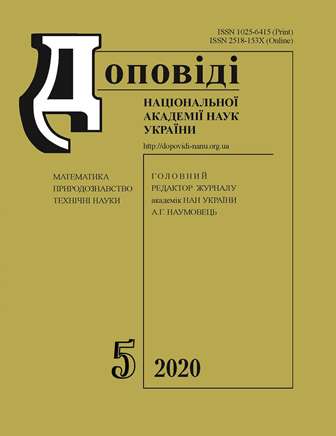Чорні мінікурці - можливий фактор утворення чорносланцевих формацій евксинського типу
DOI:
https://doi.org/10.15407/dopovidi2020.05.052Ключові слова:
евксініти, сірководнева дегазація, трубчаста проблематика, чорні курці, чорні сланціАнотація
При електронно-мікроскопічному вивченні порід нижньовізейської чорносланцевої формації евксинського типу в центральній частині Дніпровсько-Донецької западини (за керном глибоких свердловин) були виявлені фрагменти піритизованих трубок циліндричної і конусоподібної форми, заповнених коломорфним, губчастим і фрамбоїдальним піритом, що відіграє велику роль в складі чорних сланців. Мабуть, це фрагменти мікротрубчастої системи дегазації, якою в басейн седиментації надходив глибинний сірководень. Отвори в стінках трубок свідчать про розпилення двофазного флюїду на краплі рідини і бульбашки газу, при кавітації яких відбуваються мікровибухи, що перфорують стінки трубок. Знахідка цих крихких ефемерних утворень, які ймовірно є аналогами чорних курців, дозволяє конкретизувати закономірності накопичення чорносланцевих формацій евксинського типу, що має сприяти як освоєнню пов’язаних з ними вуглеводневих і мінеральних ресурсів, так і оцінці їх геоекологічного і еволюційно-біологічного значення.
Завантаження
Посилання
Jenkins, H. C. (1973). Cretaceous anoxic events from continents to oceans. J. Geol. Soc. London, 137, No. 2, pp. 171-188. Doi: https://doi.org/10.1144/gsjgs.137.2.0171
Lukin, A. E. (1999). Paleontology in the system of natural sciences. Sanct-Petersburg, pp. 48-49 (in Russian).
Lukin, A. E. (2013). Geology and minerals of the World ocean, No. 4, pp. 5-28 (in Russian).
Yudovich, Ya. E. & Ketris, M. P. (1988). Geochemistry of black shales. Leningrad: Nauka. (in Russian).
Lukin, A. E. (1997). Lithogeodynamic factors of oil and gas accumulation in aulacogenic basins. Kiev: Naukova Dumka (in Russian).
Shnyukov, E. F., Starostenko, V. I. & Gozhik, P. F. (2001). On the high gas output from Black Sea bottom. Geol. J., No. 4, pp. 7-14 (in Russian).
Maslennikov, V. V., Ayupova, N. R., Maslennikova, S. P., Tseluyko, A. S. (2016). Hydrothermal biomorphozes of pyrites fields: microtextures, microelements and criteria of detection. Ekaterinburg: RIO Ur.ORos.AN (in Russian).
Jones, M. L. (1981). Riftia pachiptila Jones Observations on the Vestimentiferan worms from Galapagos Rift. Science, 213. Doi: https://doi.org/10.1126/science.213.4505.333
Nesis, K. N. (1984). Vestimentiferans. Priroda, No. 4, pp. 87-89 (in Russian).
Lobier, L. (1990). Oases on the ocean floor. Leningrad: Gidrometizdat (in Russian).
Gebrook, A. V. (Ed.). (2002). Biology of hydrothermal systems. Moscow: KMK Press (in Russian).
Machulina, S. A. (2008). Geological conditions for the formation of a “black smoker” in the Donbas. Dopov. Nac. acad. nauk Ukr., No. 12, pp 107-110 (in Russian).
Lukin, A. E. (2003). Geodynamics and petroliferous structures of the Black sea — Azov sea region. IV Int. Conf. “Crimea-2002”. Simferopol (in Russian).
Fornari, D. J., Embley, R. W. (1995). Tectonic and volcanic controls on hydrothermal processes at the midocean ridge: An overview based on near-bottom and submersible studies. Seafloor Hydrothermal Systems: Physical, Chemical, Biological and Geological Interactions. Ed. S.E. Humphris el al. Geophysical Monograph Series, 91, pp. 1-46. Doi: https://doi.org/10.1029/GM091p0001
Volynsky, M. S. (1986). Unusual life of usual drop. Moscow: Znanie (in Russian).
##submission.downloads##
Опубліковано
Як цитувати
Номер
Розділ
Ліцензія
Авторське право (c) 2023 Доповіді Національної академії наук України

Ця робота ліцензується відповідно до Creative Commons Attribution-NonCommercial 4.0 International License.




